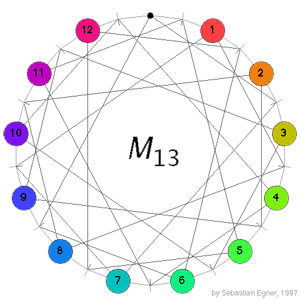 Conway’s puzzle M(13) is a variation on the 15-puzzle played with the 13 points in the projective plane $\mathbb{P}^2(\mathbb{F}_3) $. The desired position is given on the left where all the counters are placed at at the points having that label (the point corresponding to the hole in the drawing has label 0). A typical move consists in choosing a line in the plane going through the point where the hole is, choose one of the three remaining points on this line and interchange the counter on it for the hole while at the same time interchanging the counters on the other two points. In the drawing on the left, lines correspond to the little-strokes on the circle and edges describe which points lie on which lines. For example, if we want to move counter 5 to the hole we notice that both of them lie on the line represented by the stroke just to the right of the hole and this line contains also the two points with counters 1 and 11, so we have to replace these two counters too in making a move. Today we will describe the groupoid corresponding to this slide-puzzle so if you want to read on, it is best to play a bit with Sebastian Egner’s M(13) Java Applet to see the puzzle in action (and to use it to verify the claims made below). Clicking on a counter performs the move taking the counter to the hole.
Conway’s puzzle M(13) is a variation on the 15-puzzle played with the 13 points in the projective plane $\mathbb{P}^2(\mathbb{F}_3) $. The desired position is given on the left where all the counters are placed at at the points having that label (the point corresponding to the hole in the drawing has label 0). A typical move consists in choosing a line in the plane going through the point where the hole is, choose one of the three remaining points on this line and interchange the counter on it for the hole while at the same time interchanging the counters on the other two points. In the drawing on the left, lines correspond to the little-strokes on the circle and edges describe which points lie on which lines. For example, if we want to move counter 5 to the hole we notice that both of them lie on the line represented by the stroke just to the right of the hole and this line contains also the two points with counters 1 and 11, so we have to replace these two counters too in making a move. Today we will describe the groupoid corresponding to this slide-puzzle so if you want to read on, it is best to play a bit with Sebastian Egner’s M(13) Java Applet to see the puzzle in action (and to use it to verify the claims made below). Clicking on a counter performs the move taking the counter to the hole.
Category: featured
In the 15-puzzle groupoid 1 we have seen that the legal positions of the classical 15-puzzle are the objects of a category in which every morphism is an isomorphism (a groupoid ). Today, we will show that there are exactly 10461394944000 objects (legal positions) in this groupoid. The crucial fact is that positions with the hole in a fixed place can be identified with the elements of the alternating group $A_{15} $, a fact first proved by William Edward Story in 1879 in a note published in the American Journal of Mathematics.
Recall from last time that the positions reachable from the initial position can be encoded as $\boxed{\tau} $ where $\tau $ is the permutation on 16 elements (the 15 numbered squares and 16 for the hole) such that $\tau(i) $ tells what number in the position lies on square $i $ of the initial position. The set of all reachable positions are the objects of our category. A morphism $\boxed{\tau} \rightarrow \boxed{\sigma} $ is a legal sequence of slide-moves starting from position $\boxed{\tau} $ and ending at position $\boxed{\sigma} $. That is,
$\boxed{\sigma} = (16,i_k)(16,i_{k-1}) \cdots (16,i_2)(16,i_1) \boxed{\tau} $
Leave a CommentOver at the Arcadian Functor, Kea is continuing her series of blog posts on M-theory (the M is supposed to mean either Monad or Motif). A recurrent motif in them is the hexagon and now I notice hexagons popping up everywhere. I will explain some of these observations here in detail, hoping that someone, more in tune with recent technology, may have a use for them.
The three string braid group $B_3 $ is expected to play a crucial role in understanding monstrous moonshine so we should know more about it, for example about its finite dimensional representations. Now, _M geometry_ is pretty good at classifying finite dimensional representations provided the algebra is “smooth” which imples that for every natural number n the variety $\mathbf{rep}_n~A $ of n-dimensional representations of A is a manifold. Unfortunately, the group algebra $A=\mathbb{C} B_3 $ of the three string braid group is singular as we will see in a moment and the hunt for singularities in low dimensional representation varieties will reveal hexagons.
One Comment